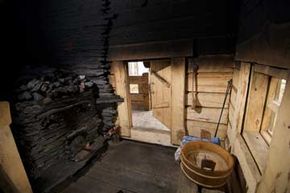Step Inside the Sauna
Now it's time to actually walk inside the sauna and discover how everything works. This is where the whole nudity thing pays off because, as we mentioned, the air inside a sauna is generally around 176 degrees Fahrenheit (80 degrees Celsius). The low humidity keeps conditions bearable, as does all the wood.
That's right, a sauna's handsome cedar or spruce décor isn't merely a stylistic choice. Metal or plastic seats would quickly become downright bun sizzling. Wood, on the other hand, remains relatively cool at high temperatures and proves rather durable. Plus, a wood interior absorbs steam, stores heat and releases soothing aromatics with every use. Tiles sometimes line the room just underneath the wood to help manage moisture and seal in the heat.
Advertisement
As for a sauna's heat source, there are a few different makes to choose from. The oldest form of sauna is the wood-burning sauna or savusauna. Forget the images of fine cedar craftsmanship for a moment and instead envision a chimneyless, windowless wooden shack in the forest. Inside, an open fire heats a pile of rocks as smoke slowly seeps through cracks in the roof. That's a wood-burning sauna. Today, this method is more the domain of sauna purists, as the smoke fills the air with eye irritants and the process of heating up the shack can take all day.
The more typical sauna design retains the basic principle of the savusauna, only without all the smoke. Instead of an open fire, a sauna uses a small stove called a kiuas. The kiuas can be electric, gas or wood burning, but the result is the same: It heats a pile of rocks. In some cases, the stove provides continual heat, while in others it only initially provides heat, which the rocks absorb and continue to emit through the surrounding air.
Not just any variety of rock will do. Sauna rocks have to stand up to high temperatures without cracking or exploding. For this reason, unweathered, quarried rock such as peridotite (a Finnish favorite), basalt and hornblende are often used.
Ready to heat things up? Skip to the next page to find out what that ladle and bucket are for.
